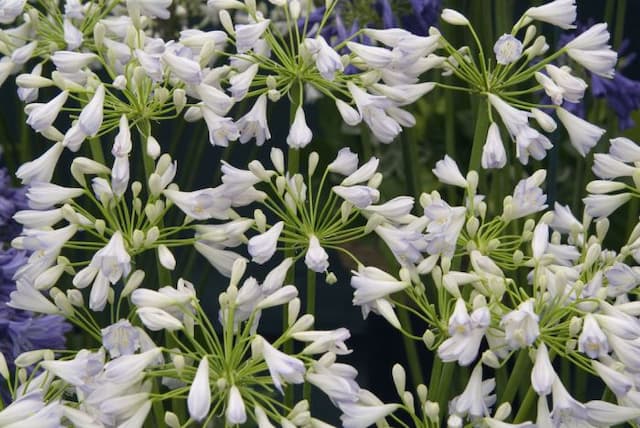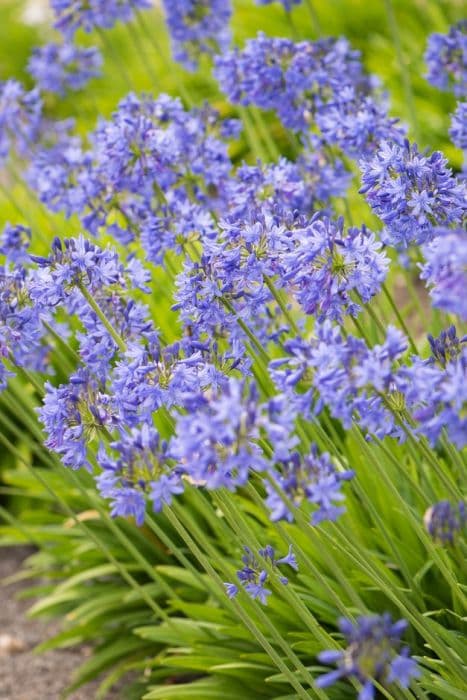African Lily Agapanthus 'Torbay'

ABOUT
Agapanthus 'Torbay', commonly known as 'Torbay' or African Lily, is a striking plant with a distinct appearance. It displays lush, strap-like green leaves that form a dense, arching clump. The foliage provides a verdant backdrop to its most notable feature: the globular clusters of funnel-shaped flowers. These blooms, typically in shades of blue or purple, create a bold visual impact. They are borne on stiff, upright stems that rise above the foliage, presenting the flower clusters like a fireworks display. The flowers attract both the eyes of passersby and pollinators like bees and butterflies. Each individual flower within the cluster has a subtle elegance, with a smooth, trumpet-like form that contributes to the overall spherical shape of the flower head. The plant, overall, exhibits a geometric precision with its straight flower stalks and rounded blooms presenting a striking outline against the softer, linear forms of the leaves below.
About this plant
 Names
NamesFamily
Amaryllidaceae.
Synonyms
African Lily, Lily of the Nile, Love Flower.
Common names
Agapanthus 'Torbay'
 Toxicity
ToxicityTo humans
Agapanthus, more commonly known as Lily of the Nile, can be toxic to humans if ingested. All parts of the plant contain substances that can cause gastrointestinal issues such as nausea, vomiting, and diarrhea if ingested. In some cases, there have been reports of dizziness and tremors. While it is not generally considered life-threatening to humans, seeking medical attention is advised if ingestion occurs, especially in children, as they are more sensitive to the toxins.
To pets
Agapanthus, commonly referred to as Lily of the Nile, is also toxic to pets, including dogs and cats. Ingesting this plant can cause vomiting, diarrhea, nausea, and in some instances, excessive drooling in animals. Although the plant is not usually life-threatening, it can cause significant discomfort and if symptoms do appear, it is important to consult a veterinarian. Pets that consume a large amount of the plant may be at greater risk, so keeping an eye on the pet and providing supportive care as instructed by the veterinarian is crucial.
 Characteristics
CharacteristicsLife cycle
Perennials
Foliage type
Evergreen
Color of leaves
Green
Flower color
Blue
Height
3-4 feet (0.9-1.2 meters)
Spread
2-3 feet (0.6-0.9 meters)
Plant type
Bulb
Hardiness zones
8
Native area
South Africa
Benefits
 General Benefits
General Benefits- Ornamental Appeal: The Agapanthus 'Torbay', commonly known as Lily of the Nile, features striking blue or purple flowers that enhance the visual appeal of gardens and landscapes.
- Easy Maintenance: It is relatively low maintenance, only requiring basic care like watering and occasional feeding to thrive.
- Drought Resistance: Once established, this plant is fairly drought-tolerant, making it suitable for regions with water scarcity issues or for gardeners seeking water-wise plants.
- Long Blooming Season: The Lily of the Nile provides a long season of bloom, often from early summer until fall, offering a prolonged period of interest in the garden.
- Attracts Pollinators: The flowers attract bees, butterflies, and other beneficial pollinators, supporting local ecosystems.
- Deer Resistant: Its foliage and blooms are generally not favored by deer; thus, it can be a good option for gardens in areas with high deer populations.
- Coastal Tolerance: Being tolerant of coastal conditions, the Lily of the Nile can be grown in seaside gardens where other plants might struggle due to salty air and soil.
- Container Gardening: It is suitable for container gardening, allowing those with limited space or unsuitable soil to enjoy its beauty.
 Medical Properties
Medical PropertiesThis plant is not used for medical purposes.
 Air-purifying Qualities
Air-purifying QualitiesThis plant is not specifically known for air purifying qualities.
 Other Uses
Other Uses- Agapanthus, commonly known as Lily of the Nile, can be used in artistic practices where the flowers are pressed or dried to create natural artwork or ornamental features in craft projects.
- The sturdy stalks of the Lily of the Nile can be woven or braided together to create small garden structures or supports for other plants.
- The sap extracted from the Lily of the Nile can be used as a natural glue for paper-based crafts, though it is not as strong as commercial adhesives.
- Lily of the Nile flowers can be used to make a natural dye for textiles or paper, producing a range of blue and purple hues.
- The leaves of the Lily of the Nile can be used in a compost pile to add bulk and increase nitrogen content, aiding the composting process.
- When planted in large groups, Lily of the Nile plants can provide a natural soil erosion barrier due to their robust root system.
- As a teaching tool, Lily of the Nile can be used to educate on plant biology and propagation techniques due to their easily observable growth habits.
- Lily of the Nile has been used in floral arrangements for weddings and other ceremonial events because of its elegant and structural bloom form.
- Photographers and painters often use Lily of the Nile as subjects in their work due to their striking appearance and the way they complement various landscapes.
- In culinary settings, while not common, the blooms can be crystallized with sugar and used as edible decorations for cakes and desserts, provided they have not been treated with pesticides.
Interesting Facts
 Feng Shui
Feng ShuiThe Lily of the Nile is not used in Feng Shui practice.
 Zodiac Sign Compitability
Zodiac Sign CompitabilityThe Lily of the Nile is not used in astrology practice.
 Plant Symbolism
Plant Symbolism- Love Letters: The name "Agapanthus" is derived from the Greek words "agape" (love) and "anthos" (flower), symbolizing 'love letters' or messages of affection.
- Beauty: With its striking blue or purple flowers, the Agapanthus is often associated with beauty and a pleasing appearance.
- Endurance: Known for its hardiness and ability to thrive in various conditions, the Agapanthus represents endurance and resilience.
- Friendship: The lush clusters of flowers may symbolize the shared strength and support found in friendships.
- Home: Since Agapanthus is often planted around homes in certain cultures, it can be seen as a symbol of domesticity and creating a welcoming environment.
 Water
WaterThe Lily of the Nile should be watered thoroughly, ensuring the soil is moist but not waterlogged. During the growing season in spring and summer, water the plant once a week with about one gallon of water per plant. Reduce watering frequency to every two to three weeks during the fall and winter months when the plant is dormant, providing only enough water to prevent the soil from drying out completely. Always check the soil moisture before watering to avoid overwatering, which can lead to root rot.
 Light
LightLily of the Nile thrives best in full sun to partial shade conditions. A spot that receives at least six hours of direct sunlight per day is ideal for optimal growth and flowering. If grown indoors, a south-facing window can provide the necessary light. However, in very hot climates, some afternoon shade will help protect the plant from intense, direct sunlight.
 Temperature
TemperatureLily of the Nile prefers temperate climates with temperatures ranging between 50°F and 90°F. The plant can survive minimum temperatures down to about 20°F, but for best growth, it should not be exposed to temperatures below freezing for prolonged periods. Ideal temperatures for Lily of the Nile are between 60°F and 80°F, where the plant can thrive and produce its characteristic blue flowers.
 Pruning
PruningPruning Lily of the Nile is important to remove spent flower stalks and promote a tidy appearance. After flowering, typically in late summer or early fall, cut the flower stalks down to the base of the plant. Pruning can also involve removing any damaged or dead foliage to encourage new growth. Pruning is generally done annually, but can be done more frequently if needed to maintain the plant's shape and size.
 Cleaning
CleaningAs needed
 Soil
SoilThe African Lily, commonly known as Agapanthus 'Torbay', thrives best in a loamy, well-draining soil mix with compost incorporated. The soil pH should be slightly acidic to neutral, ideally between 6.0 and 7.0.
 Repotting
RepottingThe African Lily should be repotted every 2-3 years or when it becomes root-bound due to its rapid growth.
 Humidity & Misting
Humidity & MistingThe African Lily prefers average humidity levels, making it suitable for most indoor environments without the need for special humidity adjustments.
 Suitable locations
Suitable locationsIndoor
Place in bright indirect light and ensure good airflow for the African Lily.
Outdoor
Plant in partial sun with good drainage for a healthy African Lily.
Hardiness zone
8-11 USDA
 Life cycle
Life cycleAgapanthus 'Torbay', commonly known as the Torbay Liliy, begins its life cycle when its black, angular seeds germinate in the spring after experiencing stratification or a period of cold to break dormancy. The seeds give rise to seedlings which develop into young plants with strap-shaped, green leaves. As the plant matures, it develops a fleshy root system and a base called a rhizome, from which more leaves and flower stalks arise. Flowering typically occurs in the summer, with tall stems topped by umbels of blue or white funnel-shaped flowers. After pollination, usually by insects, the flowers develop into capsule-like fruits which eventually open to release the seeds, thus completing the cycle. Throughout its life, an established Agapanthus 'Torbay' clump can be divided and replanted to propagate new plants.
 Propogation
PropogationPropogation time
Early summer
The most popular method of propagating the Agapanthus 'Torbay', commonly known as the Lily of the Nile, is by division. The best time to propagate by division is in the spring or early summer after the plant has finished blooming. To propagate by division, carefully dig up the plant and gently separate the clumps of rhizomes, ensuring that each division has at least one growing point or shoot. After separating, replant the divisions immediately at the same depth they were growing before and water them well to establish. Each division should be spaced about 12 to 18 inches (approximately 30 to 45 centimeters) apart to allow ample room for growth.









